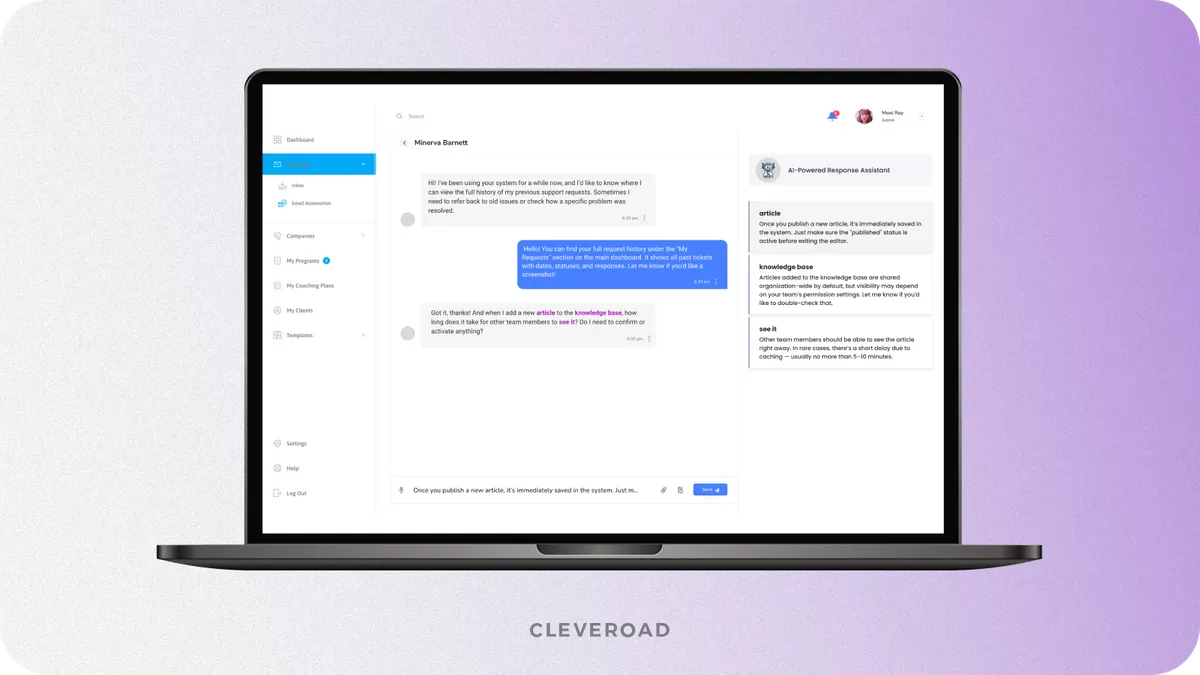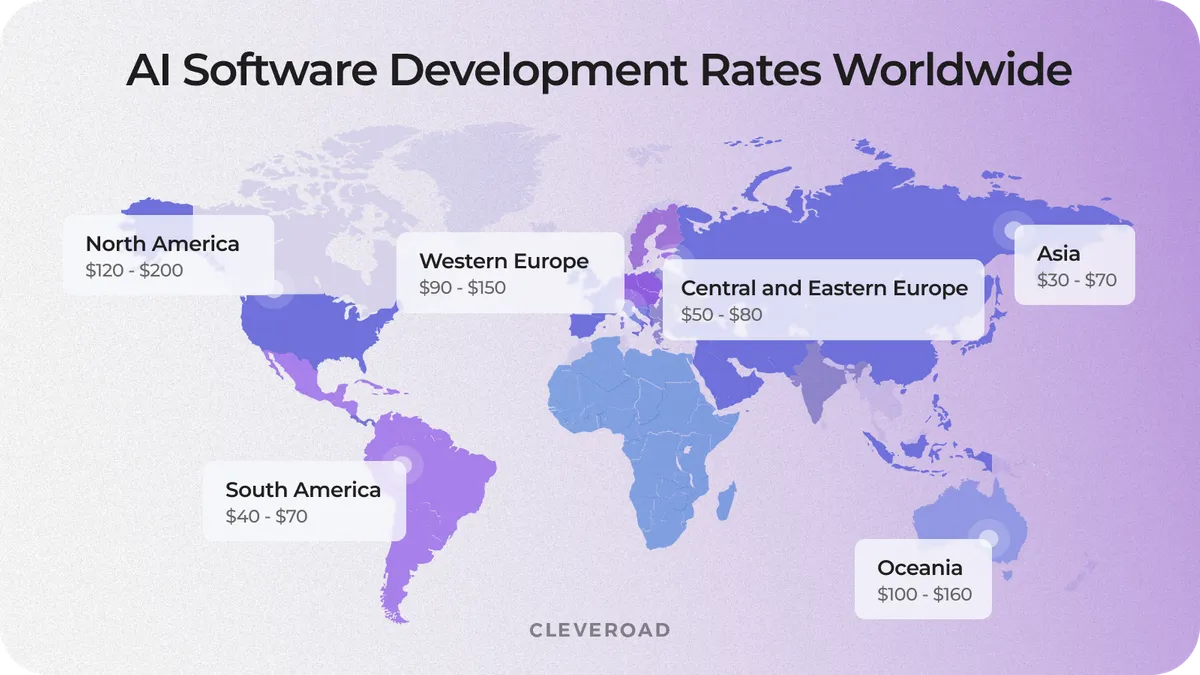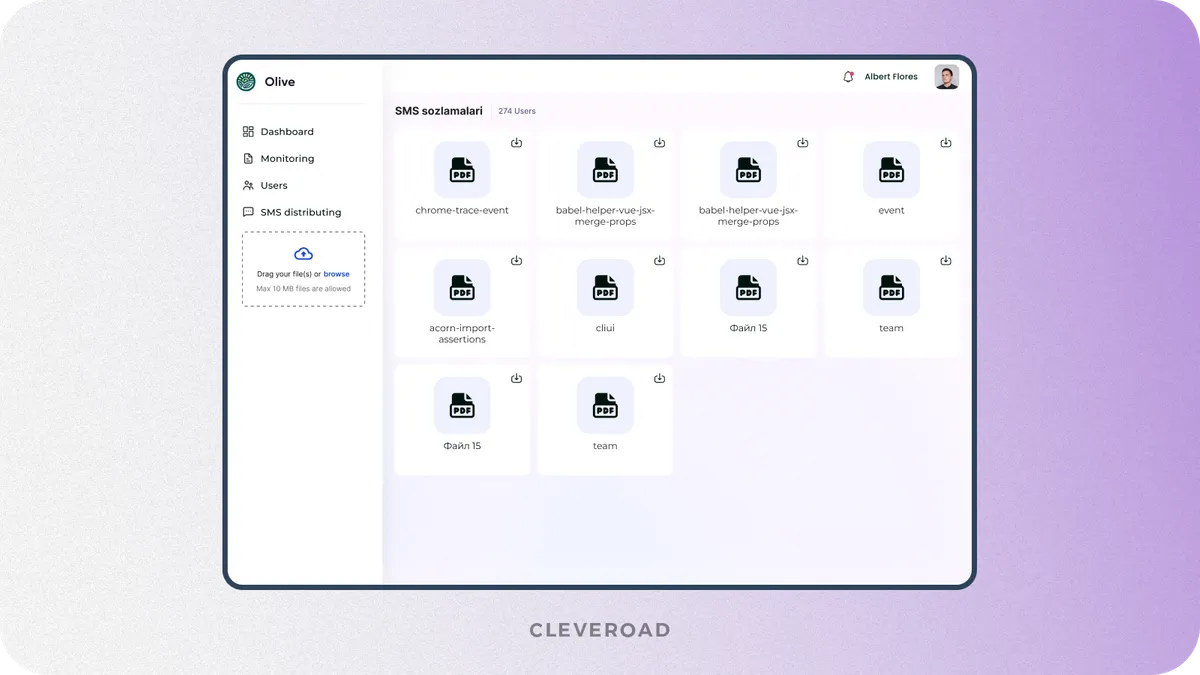Artificial Intelligence Cost Estimation for 2025: What You Can Do to Cut on Investments
13 Jun 2025
18 Min
144 Views
Figuring out the exact AI software development cost can feel like trying to hit a moving target. You're probably familiar with those budget "surprises" that can derail projects and drain resources. AI development costs range considerably, with simple chatbots starting around $20,000 and advanced Large Language Models (LLMs) like ChatGPT easily topping $300,000+, the range is huge.
But now we’ll try to get a much clearer picture. We at Cleveroad have analyzed the key factors influencing AI development costs, including hidden ones, and prepared estimated budgets for you. This guide will reveal the real cost drivers behind AI development and show you how to reduce expenses without compromising the quality or innovation of your AI solution.
What Factors Impact AI Development Cost?
Accurate artificial intelligence cost estimation is never a one-size-fits-all situation. New functionalities and technological advancements make prices shift over time. Still, based on Cleveroad’s experience in delivering advanced AI-powered solutions, we’ve identified five key factors that consistently influence development pricing. Let’s break them to help you plan smarter and avoid hidden costs.
Scope and complexity of the AI solution
The more advanced AI solution you plan to develop, the more time, resources, and specialized expertise it requires. While this might seem obvious — for example, a simple chatbot will cost significantly less than a system that analyzes medical scans or predicts complex user behavior- it's essential to understand why the costs differ. Factors such as real-time data processing, natural language understanding, computer vision, or predictive analytics add significant complexity, driving up both development time and expenses.
Here's a breakdown of typical AI solution types, their complexity, and estimated costs:
| AI solution type | Description | Typical features | Estimated cost ($) |
Simple AI solution | Basic automation or rule-based systems with minimal AI involvement |
| $20,000-$50,000 |
Medium AI solution | Involves machine learning models, some data processing, and more advanced logic |
| $50,000-$150,000 |
Complex AI solution | Advanced AI/ML models, deep learning, real-time data processing, and complex integrations |
| $150,000-$500,000+ |
Data requirements
AI requires a substantial amount of data to function effectively. If your business already has enough high-quality data, the development process becomes faster and more affordable — there’s no need for complex data preparation, external sources, or synthetic data.
But if your data is incomplete, unstructured, or low quality, AI development cost can rise quickly. You may need to invest in data cleaning, hire specialists, or generate synthetic datasets, all of which can significantly stretch your budget. For example, creating synthetic data for training AI can add thousands of dollars to the cost of early-stage development.
If you work in a regulated industry, such as healthcare or FinTech, additional costs arise from ensuring data privacy and legal compliance. Meeting HIPAA or GDPR standards may require advanced encryption, legal audits, or secure data storage, which can add to both development and long-term support budgets.
At Cleveroad, we have extensive experience in facilitating businesses with AI-based solutions, aligning their data sources, formats, and infrastructure to ensure their AI initiatives are built on a solid and reliable data foundation. Here’s what Darya Yukhymenko, our delivery manager, has in mind on data integrity with AI implementation:
Darya Yukhymenko
Delivery Manager
Clear, structured data is essential for effective AI development. Without it, projects risk delays, higher costs, and unpredictable results. Defining data needs early helps manage complexity and keeps AI maintenance costs under control
The choice of the cooperation model
Your choice of cooperation model directly shapes the overall budget, timeline, and management complexity of your AI project. Here are the three most common models:
- In-house AI team: You recruit and manage your own full-time employees. This provides full control over processes and knowledge retention, but it involves high fixed costs (such as salaries, benefits, office space, equipment, HR, and legal expenses) and longer hiring times.
- AI staff augmentation: You temporarily extend your internal team by hiring external AI specialists through a vendor. You pay only for worked hours without administrative burdens, making it easier to scale specific expertise up or down as needed.
- Dedicated AI team: You partner with a vendor that provides a fully managed team, handling recruitment, management, infrastructure, and delivery. This model combines predictable costs, fast scalability, and full-service delivery while relieving you of operational overhead.
Below we compare the three cooperation models with clear examples and cost calculations based on the hourly rate in our region (Central and Eastern Europe, Estonia), which is $50-$80:
| Cooperation model | Description | Key cost components | Example calculation |
In-house AI team | You build your own internal AI department. You fully control the team but carry all employment, administrative, and infrastructure costs |
| $12,000-$24,000 |
AI Staff augmentation | You hire individual AI specialists from an IT vendor to temporarily extend your team. Pay only for actual work hours, no extra overhead |
| $8,800-$14,080 |
Dedicated AI team | You hire a full team managed by the vendor. The vendor covers recruitment, management, infrastructure, and delivery |
| $52,800-$84,480 |
Picking the right cooperation model is only half the story, who you partner with can have just as much impact on your budget and results. According to Gartner, companies where AI teams help define success metrics are 50% more likely to adopt AI strategically. Experienced vendors don’t just write code, they help you make smarter choices early on, avoid common mistakes, and build something that can actually scale. In the end, a strong partner means fewer do-overs and smoother delivery. And while their rate might seem higher at first, it often saves you money in the long run by getting things right from the start.
Business domain
The industry you operate in significantly affects AI software development cost. Certain industries require more advanced models, larger datasets, stricter compliance, and higher accuracy, all of which increase complexity and expenses.
Here are key cost-driving factors that impact AI development cost in different business domains:
- Data complexity: Some industries (like Healthcare or Finance) deal with large volumes of highly sensitive, structured, and unstructured data.
- Model sophistication: Predictive analytics, computer vision, and NLP complexity vary by use case (e.g., medical diagnostics vs. E-commerce chatbot).
- Compliance and regulations: Industries like Healthcare, Finance, and Insurance require adherence to strict legal, ethical, and privacy regulations (HIPAA, GDPR, PCI DSS, etc.).
- Integration needs: Some sectors require complex integration with legacy systems, IoT devices, or real-time data streams.
- Accuracy and risk level: In high-stakes industries (such as Medicine, Aviation, and Finance), AI errors have serious consequences, necessitating higher R&D investment, longer validation periods, and extensive testing.
| Industry | Typical AI solutions | Estimated project cost ($) |
Healthcare | Medical image analysis, clinical decision support, patient risk prediction, drug discovery | $300,000-$1,000,000+ |
Finance and banking | Fraud detection, risk scoring, customer credit analysis, algorithmic trading | $200,000-$800,000+ |
Retail and eCommerce | Personalized recommendations, demand forecasting, chatbots, inventory optimization | $80,000-$300,000+ |
Manufacturing | Predictive maintenance, quality control (computer vision), process optimization | $150,000-$500,000+ |
Logistics and supply chain | Route optimization, warehouse automation, real-time tracking, demand forecasting | $100,000-$400,000+ |
Marketing and advertising | Customer segmentation, sentiment analysis, dynamic pricing, lead scoring | $50,000-$250,000+ |
Education | Personalized learning paths, automated grading, plagiarism detection, language processing | $50,000-$200,000+ |
Technology stack and infrastructure
Your AI solution is only as efficient as the tools and platforms powering it. A well-chosen tech stack not only accelerates development but also keeps operational costs under control.
While some components, such as open-source frameworks and programming libraries, are free to use, others, like cloud infrastructure or high-performance computing resources, require significant investment depending on your scale and use case.
Below we’ve compiled a comprehensive table representing paid tools that are commonly used for AI development and their approximate cost:
| Category | Examples | Typical cost ($) |
Cloud services for training, deployment, and scaling | AWS SageMaker, Azure AI, Google AI Platform | $0.10 – $4.00/hour per instance (depends on compute power and configuration) |
GPU/TPU instances for compute-intensive tasks | NVIDIA A100 via AWS, Google TPU v4 | $1.20 – $5.60/hour per GPU (multiple GPUs often required for large models) |
Data storage solutions for training data and model artifacts | Amazon S3, Google Cloud Storage | $0.023 – $0.12/GB per month (additional charges for access/retrieval may apply) |
Managed MLOps platforms for model lifecycle automation | AWS Bedrock, Azure ML, Vertex AI | $200 – $1,000+/month (varies by training hours, services, and scale) |
Big data processing engines for large-scale data workflows | Amazon EMR, Apache Hadoop on AWS | $0.07 – $0.27/hour per core (plus storage and bandwidth costs) |
Integration and workflow alignment
AI solutions rarely operate in isolation; they usually need to integrate with your existing business infrastructure to deliver real value. For example, let’s suppose you’re building an AI-powered customer support chatbot for a retail app. To make it fully functional and useful for your business, you might need to integrate it with:
- CRM: to access customer profiles and history.
- Payment system: to help customers check payment status or process refunds.
- Order management: to track orders and delivery status.
- Inventory system: to check product availability in real time.
Below are the most common systems your AI may need to connect with:
- CRM systems (Salesforce, HubSpot, Zoho CRM)
- ERP systems (SAP, Oracle, Microsoft Dynamics)
- Payment gateways (Stripe, PayPal, Adyen)
- Inventory management systems
- Order processing systems
- Customer support platforms (Zendesk, Freshdesk)
- Marketing automation tools (Marketo, Mailchimp)
- Analytics and BI tools (Google Analytics, Power BI)
- Loyalty programs and user accounts
- Third-party APIs (shipping, geolocation, external data sources)
Visit our service page to check out how the AI development services we provide at Cleveroad will help you avoid budget overruns and extract maximum value from AI implementation
AI Software Development Cost by Solution Type
When assessing how much does it cost to develop an AI, keep in mind that the biggest factor is always the type of solution you're building. Different AI use cases come with varying levels of complexity, data needs, and infrastructure requirements. To help you understand the expected AI pricing range, we’ve selected key AI solutions types to help you plan better, avoid scope creep, and align your budget with realistic goals.
AI chatbots and virtual assistants
Chatbots and AI-powered virtual assistants are a common entry point into AI. They handle everything from answering basic questions to guiding users through transactions or support issues.
A basic rule-based chatbot may cost $10,000–$25,000. More advanced AI assistants using natural language processing (NLP) and machine learning typically start at $50,000.
Development costs rise as feature complexity increases. Adding multilingual support requires additional data preparation, fine-tuning, and testing. Features like sentiment analysis or tone detection introduce deeper NLP layers and may rely on third-party APIs, driving both development and operational expenses. Integrating with CRMs or internal databases adds backend work, secure data handling, and custom logic, extending the project timeline by 40 to 100+ hours. Building continuous learning pipelines for adaptive behavior further increases long-term maintenance costs.
As features become more advanced, highly personalized and human-like AI assistants can cost up to twice as much as basic solutions.

AI-powered knowledge assistant designed by Cleveroad
Predictive analytics tools
Predictive analytics solutions analyze historical data to forecast trends, behaviors, or outcomes, helping businesses make more informed decisions. They’re widely used within AI in FinTech (for risk analysis), logistics (for demand forecasting), and healthcare (for early diagnosis support).
Depending on the scope and data volume, the cost of AI development for predictive analytics tools ranges from $40,000 to $100,000. Projects requiring real-time predictions, integration with live data streams, or high-accuracy outputs usually fall on the higher end. A key cost driver is data preparation, ensuring it’s clean, structured, and sufficient in volume.
Recommendation engines
Recommendation engines analyze user preferences and behaviors to suggest products, content, or services. The cost to build an AI recommendation engine varies from $30,000 to $80,000, depending on the sophistication of the model. Basic engines using collaborative filtering have a lower cost to build, while more advanced systems with hybrid filtering, user profiling, and real-time personalization require a higher investment in AI.
Beyond features, the final cost depends on how well the engine scales, processes large datasets, and integrates into your ecosystem. Advanced systems need continuous model tuning and infrastructure that supports real-time personalization. If personal data is involved, compliance with regulations like GDPR adds further complexity and cost to both development and maintenance.
Computer vision solutions
Computer vision (CV) allows machines to make decisions based on visual data, with applications in quality control, facial recognition, , and retail analytics.
These solutions are typically resource-intensive, both in computing and data needs, costing between $60,000 and $150,000+. Expenses rise with the complexity of tasks (e.g., object tracking in video vs. static image recognition), required accuracy levels, and real-time processing needs. In domains like healthcare or manufacturing, CV systems must be highly precise, adding to development and testing efforts. Building and labeling large datasets, training deep learning models, and optimizing for performance all contribute to cost.
What is the cost of AI in healthcare? Check out our guide to learn about major cost factors and comprehensive ways to optimize investments
NLP (Natural Language Processing) systems
Natural Language Processing (NLP) systems are designed to interpret, generate, or classify human language in applications like chat summarization, document tagging, or sentiment analysis. The development team you choose plays a critical role in ensuring successful AI integration, as the system could cost anywhere between $35,000 and $120,000, depending on factors such as language complexity, need for tone or context awareness, and the scope of model training.
Using pre-trained AI models like OpenAI’s GPT-4, Google’s PaLM, or Meta’s LLaMA can help reduce costs and accelerate development; however, for more specialized needs, such as supporting multiple languages, industry-specific terminology, or nuanced sentiment detection, additional data and fine-tuning are often required.
To sum up, below you can examine the cost and timeline to develop each type of AI solutions:
| AI solution type | Approximate development time (h) | Estimated cost ($) |
AI chatbots & virtual assistants | 200 - 800h | $10,000 - $50,000+ |
Predictive analytics tools | 500 - 1,200h | $40,000 - $100,000 |
Recommendation engines | 400 - 1,000h | $30,000 - $80,000 |
Computer vision solutions | 800 - 1,600h | $60,000 - $150,000+ |
Natural Language Processing (NLP) | 500 - 1,400h | $35,000 - $120,000 |
Please note that the figures above are approximate and can vary based on your specific goals, data requirements, and the purpose of your AI implementation. Don’t hesitate to contact us for a more tailored estimate aligned with your business needs.
Hidden AI Development Costs to Look Out For
Imagine: you’ve crunched the numbers, scoped the solution, and planned the rollout. But then suddenly, costs begin to spiral. Usually, this is often caused by hidden critical expenses that only surface once development is underway. And by then, your timeline, team, and budget are already locked in.
To help you mitigate these risks and avoid getting into the budgeting pit, let’s break down the overlooked elements that can quietly inflate your AI budget and impact ROI.
Model maintenance and re-training expenses
AI doesn’t just “launch and run.” After deployment, your models require continuous monitoring, updates, and retraining, especially in fast-moving industries such as e-commerce, fintech, or healthcare. Changes in customer behavior, data sources, or regulations can render your model inaccurate in weeks or months.
Neglecting this can lead to performance degradation, user trust issues, and costly emergency fixes. That’s why maintenance must be planned from the outset, with actual numbers attached.
AI model maintenance includes ongoing monitoring, regular retraining, data pipeline updates, and performance tuning to ensure accuracy and reliability over time. These activities typically cost between $3,000 and $10,000 per month, depending on the model’s complexity and usage.
Third-party integration and API usage fees
To function efficiently, AI systems often rely on third-party services – language models, vision APIs, vector databases, or analytics tools. Common providers include OpenAI, Google Cloud, AWS, Hugging Face, Pinecone, and others. These services typically use pay-per-use pricing. While initial costs may seem low, expenses can escalate quickly as usage scales.
Additionally, integrating APIs often requires extra development hours for middleware, authentication logic, and data formatting. Depending on complexity, this can add 40 – 80+ engineering hours to your initial development budget.
- Note: The following costs are separate from infrastructure or tech stack expenses (e.g., hosting, database management, CI/CD pipelines).
| AI service/tool | What it does | Sample pricing (as of 2025) | Cost impact at scale |
OpenAI GPT-4-turbo | Language model API | ~$0.01 per 1K input tokens / ~$0.03 per 1K output tokens | $1,500/month for ~1M user queries |
Google Vision API | Image recognition, OCR | ~$1.50 per 1K units (labels, text, faces, etc.) | $750/month for 500K image analyses |
Pinecone | Vector search & semantic memory | ~$0.096/hour per pod + storage & query costs | $300–700/month for moderate usage |
Hugging Face Inference API | Model hosting & inference | Starting at $0.06/minute compute time | $500+/month for active AI applications |
AWS Comprehend | NLP services (sentiment, key phrases) | ~$1.00 per 1K units | $100–300/month for basic text pipelines |
How to Cut AI Development Cost?
The logical question that immediately pops up: ‘How can I cut on investments during AI development and implementation?’ Below, we’ve gathered valuable tips that may help you avoid budget overruns during AI software development.
Outsource AI software development
Outsourcing AI development allows businesses to access top-tier specialists, proven workflows, and ready-to-go infrastructure without the high costs of in-house hiring. You avoid expenses like salaries, benefits, office space, and recruitment, paying only for actual work delivered.
With experienced partners, projects start faster and avoid costly mistakes thanks to established pipelines and AI expertise. Outsourcing also offers flexibility, letting you scale your team and expertise as your project evolves.
Below you can overview outsourcing software development rates worldwide:

AI software development rates worldwide
Central and Eastern Europe has become one of the most attractive outsourcing destinations, offering an excellent balance of technical expertise, reliable delivery, and competitive pricing. Thanks to its strong STEM background, companies here provide high-quality AI services at significantly lower costs than North America or Western Europe.
Cleveroad is an outsourcing AI development company from Central and Easter Europe (CEE region) headquatered in Estonia. We have R&D centers in Estonia, Norway, Ukraine, and USA.
At Cleveroad, we help businesses optimize AI development by providing:
- Experienced AI specialists
- Ready-to-use components and workflows
- Flexible cooperation models
- Industry-specific expertise
We’d like to share with you our recent case – Custom Presentation Solution for AVFX, a Leading Event Production Company.
AVFX is a leading US-based event production company specializing in complex live event management. They chose Cleveroad as their technology partner since we offered not only a competitive pricing model but also a deep understanding of their unique business needs from day one. As a result, we developed a tailored Presentation Solution that includes a user-friendly Web Portal for content management and a reliable On-Premise App Suite to ensure smooth event execution.
Through a transparent and flexible cooperation model, Cleveroad ensured clear communication, rapid adaptability, and built a strong partnership from day one. The team provided proactive, around-the-clock support, including real-time assistance during major live events, successfully powering a large-scale production with 75 workstations.
As a result, AVFX achieved a scalable, reliable solution that simplified event preparation, improved live event stability, and eliminated the need for costly in-house development.
Discover more about how AVFX partnered with Cleveroad to transform their event management experience by reviewing a video feedback:
AVFX feedback on collabaration with Cleveroad
Reuse modular components across AI solutions
Reusing modular components across AI solutions reduces development time and effort by eliminating the need to build common features from scratch for each project. It enables faster integration, simplifies maintenance, and promotes consistency in performance. This approach also lowers testing and debugging costs since proven modules have fewer errors. Overall, modular reuse streamlines workflows and cuts expenses by maximizing existing resources rather than duplicating work.
At Cleveroad, we apply modular and reusable architecture to help clients reduce AI development costs, accelerate delivery, and simplify future scaling. Instead of building everything from scratch, we leverage a library of pre-built, production-tested modules that can be quickly adapted to each project.
Typical reusable modules we apply include:
- Data processing pipelines (ETL, feature extraction)
- User authentication & access control (OAuth, SSO)
- Model monitoring & drift detection dashboards
- Annotation & labeling tools for supervised learning
- API management layers for integrations
By using modular components, clients not only reduce initial development costs but also benefit from lower maintenance, faster scaling, and reduced long-term risks.
Start with an AI Proof-of-Concept (PoC)
AI Proof-of-Concept (PoC) is a small-scale, low-risk project designed to test whether a specific AI solution can effectively solve your particular business challenge. Instead of building a full product upfront, a PoC focuses on the core functionality just enough to validate the idea, prove technical feasibility, and assess potential value.
For example, if you’re considering a recommendation engine, the PoC might include building a basic version using a limited dataset to see how accurately it suggests items. This approach helps reduce uncertainty, avoid large upfront costs, and make informed decisions before committing to full-scale AI technology implementation. By funding only this initial phase, you minimize the risk of sinking money into unproven ideas. Once the PoC shows clear potential, you can confidently proceed with full development.
Cleveroad helped an insurance company validate AI’s value through a focused Proof-of-Concept (PoC) for an Intelligent Document Processing (IDP) system. The team started by analyzing existing document workflows to identify bottlenecks in classification and data handling. Based on these insights, we designed and tested a PoC that automated document classification and data extraction for key insurance scenarios.
Here’s key challenges our AI PoC development services solved within the clients business model:
- Identified inefficiencies in data handling through in-depth workflow analysis
- Designed a targeted PoC to automate key insurance document processing tasks
- Validated automation feasibility and performance across high-impact insurance use cases
- Achieved a 75% reduction in processing time, proving the value of AI-driven IDP
- Reduced development risk by confirming real-world effectiveness before full implementation

AI-driven document intelligence system designed by Cleveroad
Avoid overengineering with just-enough customization
Overengineering drives up costs by adding features or customizations that don’t deliver measurable value. Instead, build only what’s essential to solve your core business challenge. Cleveroad follows a lean customization approach, using proven frameworks, libraries, and pre-trained AI models to accelerate delivery and reduce technical debt.
As an AWS Select Tier Partner, we leverage services like Amazon SageMaker and Amazon Bedrock to integrate and fine-tune foundation models for your specific use case, whether it’s a product recommender or a virtual assistant. Thus, we deliver high-performing solutions faster without unnecessary complexity or cost. You get an AI system tailored to your needs, not bloated technology.
How We at Cleveroad Can Help You Develop a Cost-Efficient AI Solution
Cleveroad is an IT vendor with over 13 years of experience in IT. Whether you're just exploring AI or ready for full-scale integration, we partner with you through every stage, from business analysis and PoC design to model development, deployment, and ongoing optimization.
Here’s how you’ll benefit from cooperating with us:
- Certified development: Partnership with a vendor certified under ISO/IEC 27001:2013 (information security) and ISO 9001:2015 (quality management), ensuring our high-level quality management systems and security management for your AI solution development.
- Full-cycle AI & generative AI services: End-to-end AI development support covering the entire adoption lifecycle, from AI workshop and ROI-driven use case discovery to cost-effective development and implementation.
- Skilled cross-functional AI teams: A core team of senior and mid-level engineers proficient in machine learning, NLP, computer vision, and GenAI. They bring experience in handling large datasets, complex AI architectures, and performance-critical systems.
- Flexible engagement models: Choose from IT staff augmentation, Dedicated Development Teams, or fully managed AI project delivery, adaptable to your business scale and budget.
- Advanced technology integration: Seamless connectivity with third-party AI tools, APIs, and cloud services (e.g., OpenAI, Hugging Face, AWS SageMaker, Azure ML), enabling faster time-to-market and optimized AI performance.
To prove our expertise and show how we optimize our clients' AI product development costs, we’d like to showcase on of our recent projects – AI Diagnostic Assistant for a Healthcare Provider.

AI diagnostics assistant for healthcare provider developed by Cleveroad
A healthcare facility in the US teamed up with us to create an AI diagnostic assistant. Along with the client, we started by taking a close look at their current clinical workflows and quickly spotted some important inconsistencies in how diagnoses were being made. This thorough review helped us identify the areas where our AI could truly make a difference.
Within just three weeks, Cleveroad developed a cost-effective Proof-of-Concept (PoC) for a medical image analysis assistant focused on basic image annotation. The AI model was trained on a curated dataset to recognize and label key diagnostic features in radiological images, enabling faster preliminary assessments while minimizing upfront investment. The PoC integrated seamlessly into existing clinical tools, allowing practitioners to test AI-assisted annotations without disrupting their routine workflows.
As a result, the PoC testing revealed a 40% reduction in case review time, demonstrating a strong ROI-driven use case for early diagnostics and accelerated clinical decision-making. By automating routine image annotation tasks, the assistant freed up clinicians to focus on more complex cases and interpretation, ultimately aiming to improve patient outcomes while optimizing resource utilization.
Get a custom AI cost estimate now
Book a strategic call with Cleveroad’s AI experts today. We’re ready to help you navigate the complexities of AI development and provide a tailored cost estimate that fits your unique business needs
The cost of developing an AI system can vary widely depending on factors such as the complexity of AI technologies used, development time and costs, and the expertise of skilled AI software developers involved. Developing such an AI might cost anywhere from $10,000 for simpler AI projects like basic chatbots to over $500,000 for more complex AI app development. The version of your AI and the specific AI algorithms required will also drive up the cost. Working with a reliable AI app development company experienced in custom AI development can help optimize your AI investment.
Key factors that impact the cost of building an AI solution or system include:
- Complexity of an AI: Developing the AI can range from simpler AI models to highly complex systems with advanced features.
- Development time and costs: Longer timelines and more iterations increase the expenses.
- Data requirements: The quality of data needed for training AI algorithms affect costs.
- Skilled AI software developers: Hiring experienced developers is crucial but can increase costs.
- Integration challenges: Incorporating AI with existing systems can add to expenses.
- Ongoing maintenance: AI systems require regular updates and retraining.
- Compliance and security: Industry-specific regulations can also drive up the cost.
AI app development cost depends on the different types of AI solutions you want to build. For example, developing an AI chatbot will be significantly less expensive than developing such an AI-powered diagnostic assistant or a self-learning recommendation system. Different types of AI solutions come with varied costs based on their complexity, AI algorithms involved, and the data they process. It’s essential to find out how much a custom AI development project could cost based on your specific business goals and the AI technologies needed.
Hidden costs can quickly add up and impact your budget if not accounted for:
- Data collection, cleaning, and preprocessing overhead
- Costs of ongoing model maintenance and re-training
- Third-party API usage and integration fees
- Cybersecurity measures to protect AI software
- Employee training and workflow adaptation
- Cloud infrastructure and storage costs
Being aware of these factors helps you better plan and cut down the AI costs effectively.
To optimize AI investments and lower costs without sacrificing quality, consider these strategies:
- Use pre-built AI models or platforms to speed up development
- Start with an AI Proof-of-Concept (PoC) to validate the system early
- Work with an experienced AI app development company that offers flexible engagement models like IT staff augmentation or dedicated teams
- Avoid overengineering by focusing on just-enough customization
- Outsource parts of development to regions with lower-cost labor
- Leverage cloud computing for scalable infrastructure

Evgeniy Altynpara is a CTO and member of the Forbes Councils’ community of tech professionals. He is an expert in software development and technological entrepreneurship and has 10+years of experience in digital transformation consulting in Healthcare, FinTech, Supply Chain and Logistics
Give us your impressions about this article
Give us your impressions about this article
